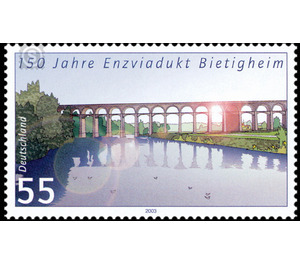bridges - Germany / Federal Republic of Germany 2003 - 55 Euro Cent
Theme: Architecture
| Country | Germany / Federal Republic of Germany |
| Issue Date | 2003 |
| Face Value | 55.00 |
| Perforation | K 13 1/2 |
| Stamp Type | Postage stamp |
| Item Type | Stamp |
| Chronological Issue Number | 2232 |
| Chronological Chapter | GER-BRD |
| SID | 76446 |
| In 29 Wishlists | |
The first railway line in Württemberg was built in 1844 from Esslingen via Stuttgart to Ludwigsburg. Towards the north, it was extended from 1847 via Bietigheim to Heilbronn. The crossing of the Enz valley presented a special challenge. In order to create a permanently stable bridge, the architect Karl Etzel chose a stone construction in his design. From 1851 to 1853 was up to 33 meters high and 287 meters long Enzviadukt. The building is based on 21 stone arches and consists of 5,000 tons of stone. It has two levels. On the upper run the rails for rail traffic, the lower is reserved for pedestrians. The railway connection made possible by the viaduct promoted the industrial boom of south-west Germany and the coalescence of the Baden and Württemberg regions. Today, the Enz Viaduct in Bietigheim is considered the landmark of the city. Every day it is used by about 300 trains.


